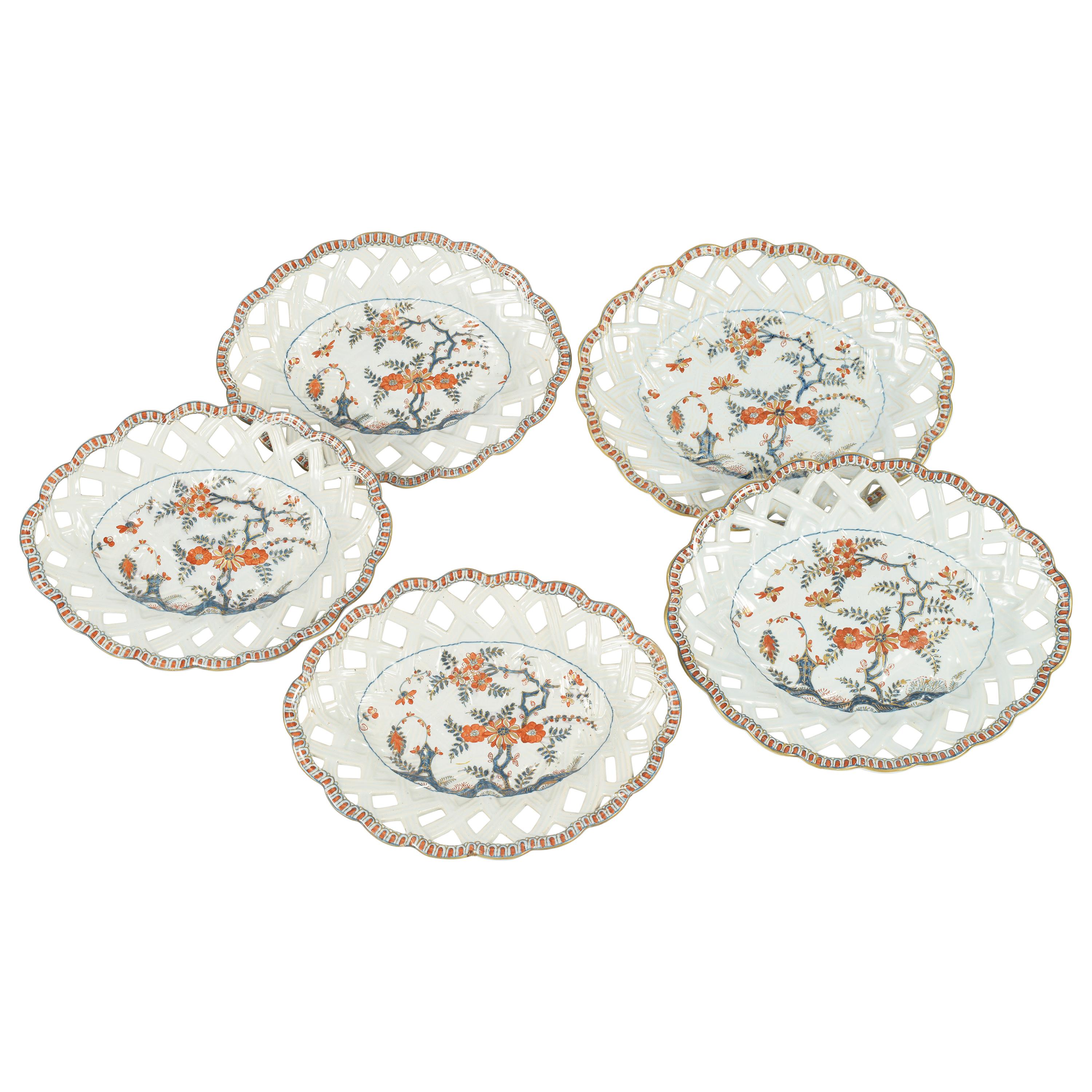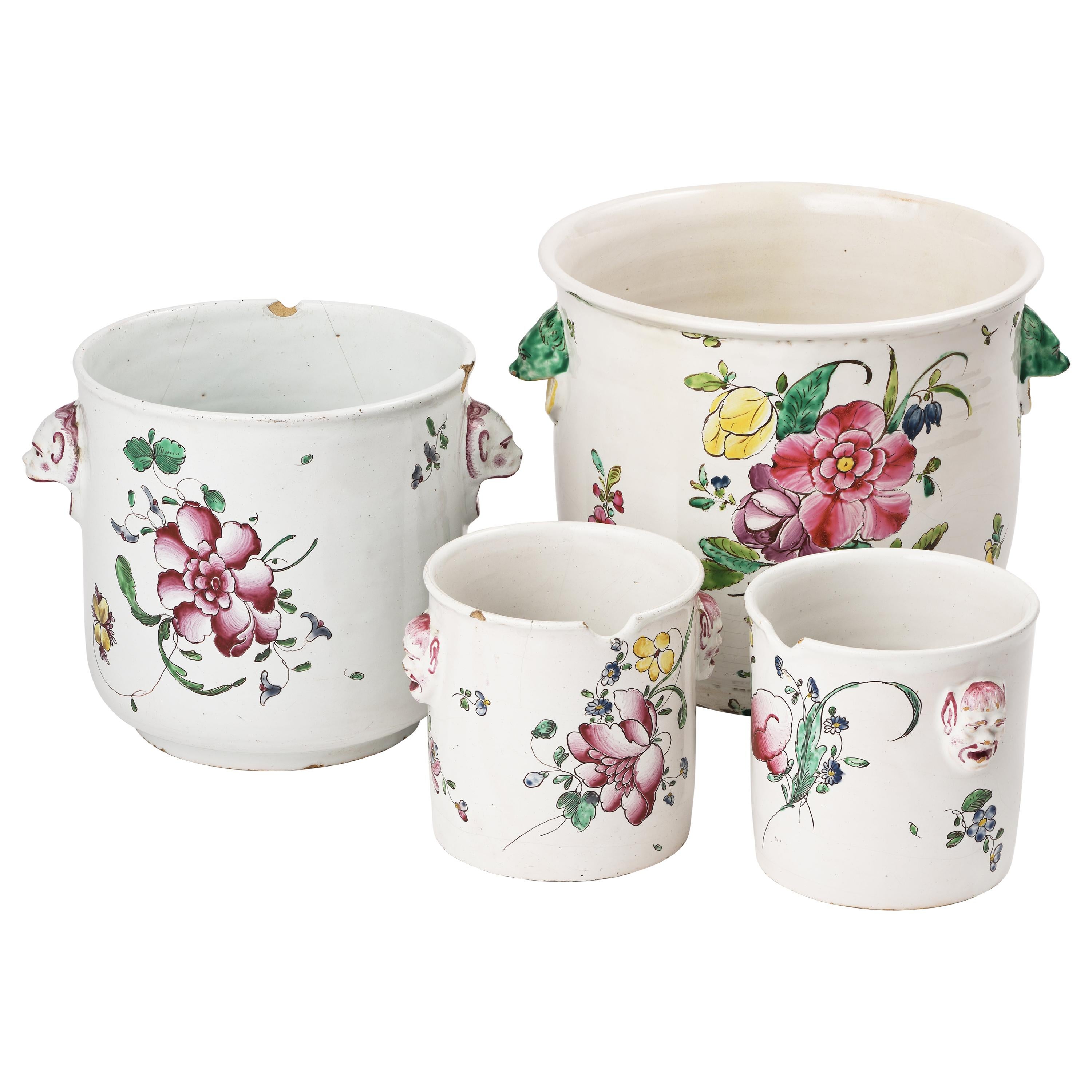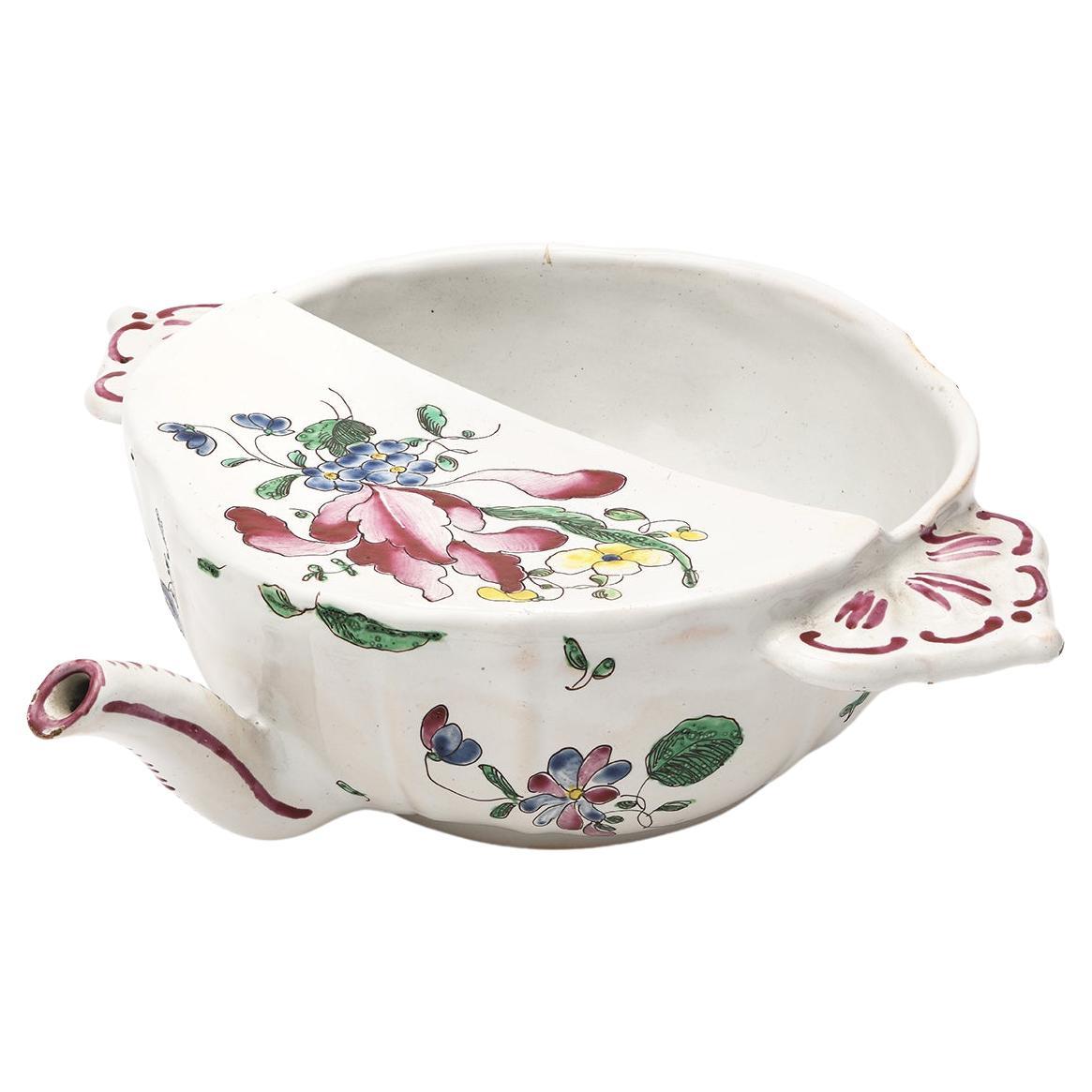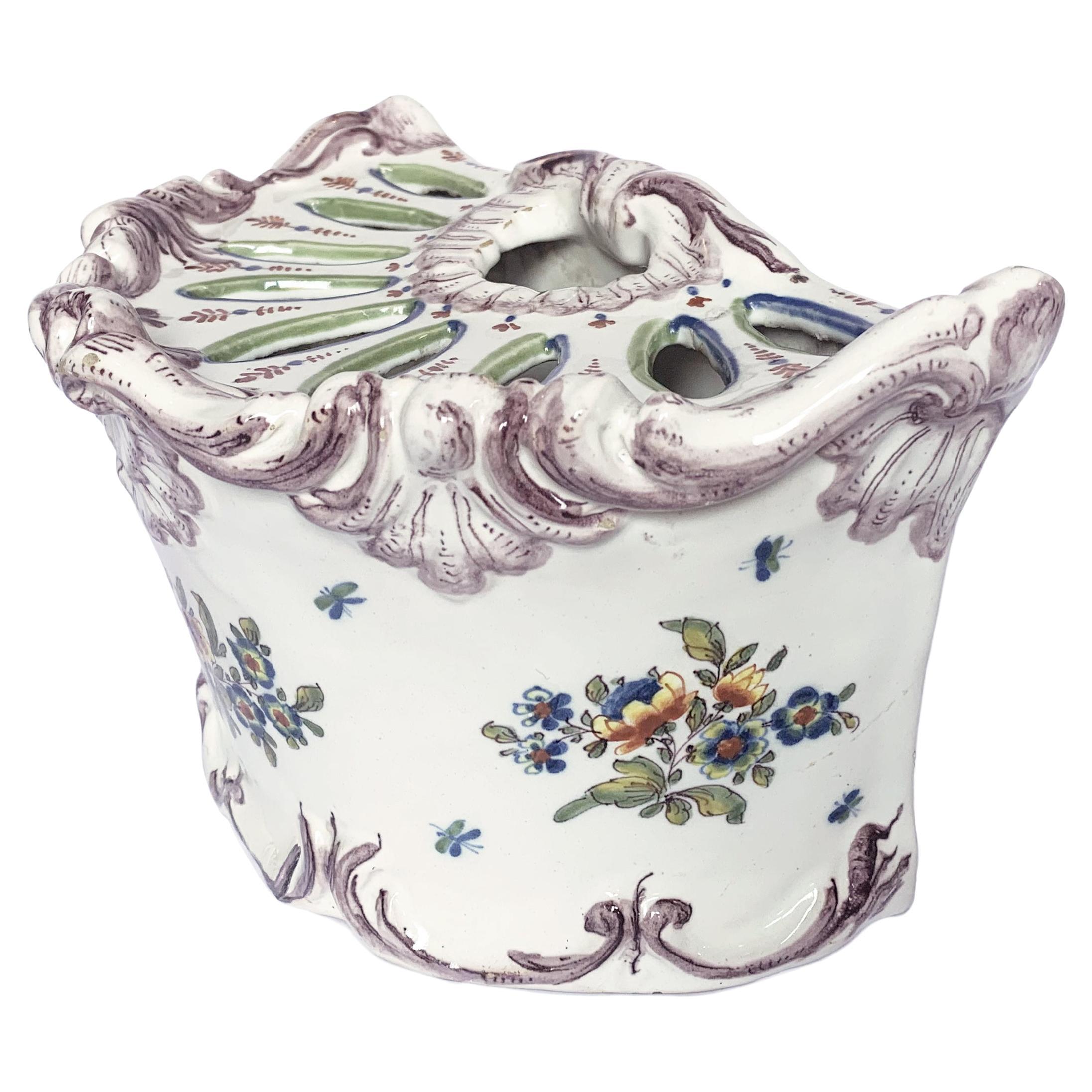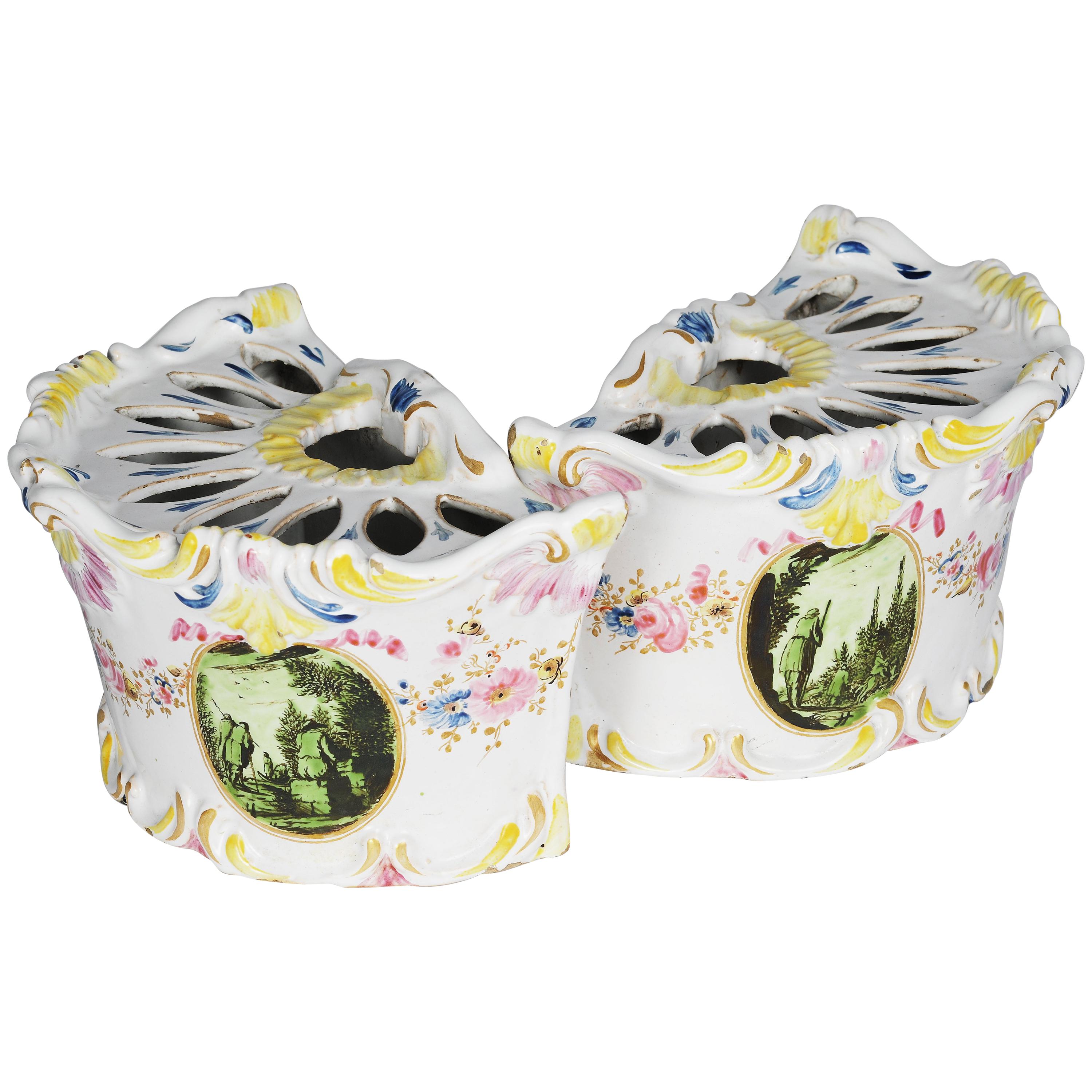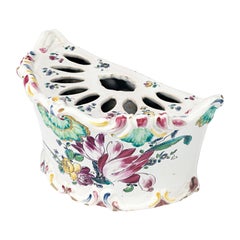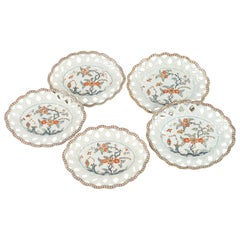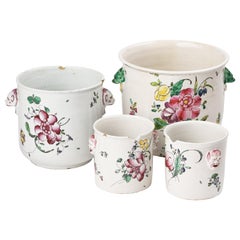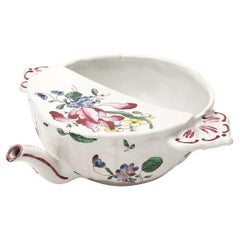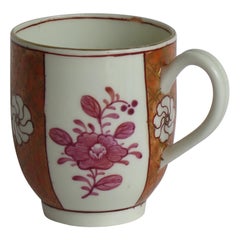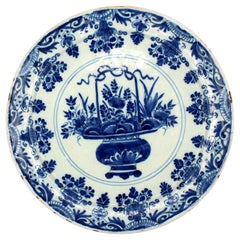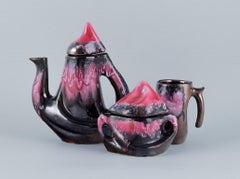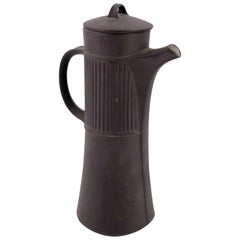Items Similar to Ancient Pair Coffee Pots, Pasquale Rubati Manufacture Milan, 1770 circa
Video Loading
Want more images or videos?
Request additional images or videos from the seller
1 of 18
Ancient Pair Coffee Pots, Pasquale Rubati Manufacture Milan, 1770 circa
About the Item
Pair of small coffee pots.
Manufacture of Pasquale Rubati
Milan, 1770 Circa
Maiolica polychrome decorated “a piccolo fuoco” (third fire).
a) height 7.87 x 5.51 x 3.93 in (20 x 14 x 10 cm); weight 0.74 lb (339 g)
b) height 7.08 x 5.51 x 3.93 in (18 x 14 x 10 cm); weight 0.68 lb (310 g)
State of conservation: a) good the body: it has small signs of use on the foot and hem and a subtle fêlure on the foot and along the side. The lid is recomposed from several fragments with some repainting.
b) A fêlure on the body probably closed during restoration with some repainting. The lid, not the original, was cast in a later period and has some repainting and small signs of use on the foot and hem.
The maiolica and porcelain factories of the eighteenth century belonged mainly to the great royal families or to the noble families who made the manufacture of ceramic works a motif of prestige. In Milan, under Maria Theresa of Austria, we instead witness a real opening to new industrialists who, by virtue of the privatization granted by the government, took on real business risks and gave life, even amid conflict between them, to flourishing factories. It was here that there was to be some of the most elegant and sought-after production of the moment, artworks which still remain objects of collection today.
In Milan in the 18th century, two majolica factories were active. The first was that of Felice Clerici, from 1745, and the second was opened by Pasquale Rubati in 1756, in competition with Felice, for whom he had been a worker. Upon Rubati's death, in 1796, the enterprise was continued for a few years under his son Carlo.
The small coffee pots, which make up a rare set of products from the Pasquale Rubati manufacture, have a pear shape with a ribbed body, resting on a low flared foot. The spout is a shelf and the handle is in the shape of intertwined twigs that open at a certain point into thin leafy branches. The lid is a cap surmounted by a small fruit. The spout of one is decorated with three colors and edged in yellow, while the other in pink shades.
The decoration, made with colors “a piccolo fuoco” (third fire), covers the body with flowered bouquets of roses and tulips and small secondary flowers scattered along the surface.
This type of object has numerous morphological comparisons in Milanese specimens with decorations "al carabiniere", "allo struzzo", "assortment with green flowers" and "heart" (R. Ausenda in R. Ausenda, Museo d'Arti Applicate, Le Ceramiche, T II, Milan 2001, nn. 307; 309; 315; 327; 372; and relative bibliography) and is probably inspired by similar specimens of porcelain very popular in the eighteenth century.
A precise comparison is represented by three specimens preserved at the Museum of Applied Arts of the Castello Sforzesco in Milan (invv. 2172; 4081; 4076). The decoration itself finds confirmation in objects from the last phase of manufacturing (R. Ausenda in R. Ausenda, Museo d'Arti Applicate, Le Ceramiche, T II, Milan 2001, pp. 387-391, and relative bibliography).
Bibliography:
R. Ausenda in R. Ausenda, Museo d’Arti Applicate, Le Ceramiche, Tomo II.
- Attributed to:Pasquale Rubati (Manufacturer)
- Dimensions:Height: 7.88 in (20 cm)Width: 3.94 in (10 cm)Depth: 5.52 in (14 cm)
- Sold As:Set of 2
- Style:Neoclassical (In the Style Of)
- Materials and Techniques:Maiolica,Glazed
- Place of Origin:
- Period:1760-1769
- Date of Manufacture:circa 1770
- Condition:Repaired: a) A subtle fêlure on the body. The lid is recomposed from several fragments with some repainting. b) A fêlure on the body. The lid is not original. Minor losses.
- Seller Location:Milano, IT
- Reference Number:1stDibs: LU4352230410932
About the Seller
4.3
Vetted Professional Seller
Every seller passes strict standards for authenticity and reliability
Established in 1860
1stDibs seller since 2018
21 sales on 1stDibs
Associations
International Confederation of Art and Antique Dealers' Associations
- ShippingRetrieving quote...Shipping from: Milano, Italy
- Return Policy
Authenticity Guarantee
In the unlikely event there’s an issue with an item’s authenticity, contact us within 1 year for a full refund. DetailsMoney-Back Guarantee
If your item is not as described, is damaged in transit, or does not arrive, contact us within 7 days for a full refund. Details24-Hour Cancellation
You have a 24-hour grace period in which to reconsider your purchase, with no questions asked.Vetted Professional Sellers
Our world-class sellers must adhere to strict standards for service and quality, maintaining the integrity of our listings.Price-Match Guarantee
If you find that a seller listed the same item for a lower price elsewhere, we’ll match it.Trusted Global Delivery
Our best-in-class carrier network provides specialized shipping options worldwide, including custom delivery.More From This Seller
View AllAncient Maiolica Flower Pot Pasquale Rubati Factory, Milan Circa 1770
By Pasquale Rubati
Located in Milano, IT
Maiolica flower pot “a mezzaluna” decorated with tulip
Pasquale Rubati Factory
Milan, circa 1770.
Measures: 4.7 in x 4.7 in x 8.6 in
12 cm x 12...
Category
Antique 1770s Italian Rococo Ceramics
Materials
Maiolica
Ancient Maiolica Plates Pasquale Rubati, Milan Circa 1770-1780
By Pasquale Rubati
Located in Milano, IT
Five oval maiolica dishes with pierced edge
Manufacture of Pasquale Rubati
Milan, 1770-1780
Three small oval dishes 10.23 in x 7.67 in (26 cm x 19.5 cm)
Two large oval dishes 10.82 in x 8.85 in (27.5 x 22.5 cm)
lb 3.5 (kg 1.8)
State of conservation: intact
The five dishes of different sizes have an oval shape, a mixtilinear edge and a molded polylobed shape with a surface enriched with a relief weave motif extending to the brim and forming a perforated basket...
Category
Antique 1770s Italian Rococo Ceramics
Materials
Maiolica
Antique Italian Maiolica Coolers Pasquale Rubati Manufacture Milan, 1770 Circa
By Pasquale Rubati
Located in Milano, IT
Assortment of bottle and glass coolers in Maiolica.
Pasquale Rubati manufacture
Milan, circa 1770
Maiolica polychrome decorated “a piccolo fuoco” (third fire)
a - Bottle cooler
5.91 in x 5.91 in diameter (15 x 15 cm )
Weight: 1.86 lb (845 g)
b - Bottle cooler
6.89 x 7.87 in diameter (17,5 x 20 cm)
Weight: 2.09 lb (948 g)
c - Pair of glass-cooler vases
3.94 x 3.94 in diameter (10 x 10 cm)
Weight: 1.43 lb (650 g)
Good state of conservation:
a - some chipping from use on the edge;
a - two fêlures covered on the edge;
c - one has deep chippings on the edge and the other a subtle fêlure.
Two Majolica factories were active in Milan in the 18th century. The first, starting from 1745, was owned by Felice Clerici; the other one by Pasquale Rubati from 1756. Rubati was in competition with Felice, whose worker he had been prior to opening his own workshop. On his death in 1796, the business was continued for a few more years by his son Carlo.
Recent studies have recognized Pasquale Rubati's contribution as the creator of "Strasbourg-style" decorations with their particularly joyful depictions. This style had previously been attributed to the Lodi manufacturers. These works here, however, are a clear example of this production.
The Majolica containers have different sizes, a cylindrical shape and rest on a low foot ring. The two largest are completed by handles in the shape of a zoomorphic mask with wide open jaws, while the smaller ones have handles applied with an anthropomorphic mask.
All the works are characterized by elegant floral decoration.
The two twin glass coolers show bunches of flowers centered around a main corolla, a rose or a peony paired...
Category
Antique 1770s Italian Rococo Ceramics
Materials
Maiolica
Ancient Maiolica Cup, Rubati Manufacture, Milan, Circa 1770 - 1780
By Pasquale Rubati
Located in Milano, IT
Sick cup
Pasquale Rubati Manufacture
Milan, Circa 1770 - 1780
Maiolica decorated in polychrome “a piccolo fuoco” (third fire)
It measures: h 2.36 x 7.4 x 7.87 (h 6 x 19 x 20 cm)
...
Category
Antique 1770s Italian Rococo Ceramics
Materials
Maiolica
Maiolica flower pot "a mezzaluna," Pasquale Rubati Factory, Milan, circa 1770
By Pasquale Rubati
Located in Milano, IT
Majolica flower pot "crescent" decorated in manganese
Pasquale Rubati Factory
Milan, c. 1770
4.92 in x 8.66 in x 5,31 in
12.5 cm x 22 cm X 13.5 cm
Weight: 2.29 lb (1039 g)
State of conservation: intact with slight chipping due to use in relief parts
A rare example of a flower pot "a mezzaluna" produced by the manufactory of the refined painter Pasquale Rubati, who opened a factory in Milan in 1756 to compete with Felice Clerici...
Category
Antique 1770s Italian Rococo Ceramics
Materials
Maiolica
Pair of Ancient Italian Maiolica Flower Pots Milan, Rubati Factory, 1770 circa
By Pasquale Rubati
Located in Milano, IT
Maiolica flower pot “a mezzaluna”
decorated with trompe l’oeil
Pasquale Rubati Factory
Milan, circa 1770
Measures: each 4.7 in (cm 12) x 5 in (c...
Category
Antique 1770s Italian Rococo Ceramics
Materials
Maiolica
You May Also Like
First Period Worcester Coffee Cup Porcelain Finely Hand Painted, circa 1770
By 1st Period Worcester Dr. Wall
Located in Lincoln, Lincolnshire
This is a rare first period (or Dr. Wall) Worcester Coffee Cup, with a distinctive hand painted pattern, made of porcelain and dating to the 18th century, circa 1770.
The cup is well potted with a grooved loop handle
This delightful early Worcester Cup...
Category
Antique 18th Century English George III Ceramics
Materials
Porcelain
Circa 1770 Delft Blue & White Plate
Located in Chapel Hill, NC
Circa 1770 Delft blue & white plate. Central handled & footed basket vase overflowing with flowers, surrounded by alternating repetive floral vases & natura...
Category
Antique 1770s Dutch Ceramics
Materials
Ceramic
Vallauris, France, Coffee Pot, Lidded Bowl and a Coffee Mug
Located in Copenhagen, DK
Vallauris, France, coffee pot, lidded bowl and a coffee mug. Luster glaze.
1960/70s.
In good condition with an insignificant small chip on the spout.
Marked.
Coffee pot measures:...
Category
Vintage 1960s French Tableware
Materials
Ceramic
$320 Sale Price / set
20% Off
Dansk Design Coffee Pot by Quistgaard
By Jens Quistgaard, Dansk
Located in San Diego, CA
Beautiful tall ceramic coffee pot designed by Quistgaard for Dansk circa 1950s, in great condition no chips or cracks.
Category
20th Century Danish Scandinavian Modern Ceramics
Materials
Pottery
$180 Sale Price
20% Off
Mid-Century Birkenhammer Czechoslovakian Porcelain Coffee Pot, 1969
Located in Praha, CZ
This mid-century piece features a sleek white body adorned with refined gold floral motifs and a gold accent band around the top. Its sharp, modernist handle and spout give it a soph...
Category
Vintage 1960s Czech Mid-Century Modern Ceramics
Materials
Ceramic
New Old Stock Czech Raw Ceramic - Coffee Pot
Located in Hook, Hampshire
New Old Stock Czech Raw Ceramic - Coffee Pot.
This white raw ceramic coffee pot was made in Czech in the late 20th Century. We recently cleared a ceramics factory in the Czech repu...
Category
Late 20th Century Czech Ceramics
Materials
Ceramic
Recently Viewed
View AllMore Ways To Browse
Rose Point Silver
18th Century Coffee Pot
1745 Glass
Verde Luana
Verdi Alpi Side Table
Vernors Vintage
Verre Eglomise Screen
Versace Christmas Plate
Versace Coffee Set
Versace Dinnerware
Versace Jug
Versace Marco Polo
Versace Tea Cup And Saucer
Vertigo Cabinet
Vertigo Movie
Vervoordt Sofa
Very Old Blue Canton Plate
Very Small Swedish Writing Table

